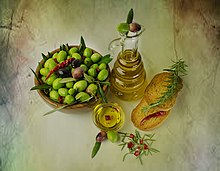Mediterranean cuisine
The term Mediterranean cuisine or Mediterranean cuisine is often in cookbooks and colloquially as a generic term for the various national cuisines of the Mediterranean region used. While these cuisines share some common elements, such as the frequent use of olive oil , Mediterranean herbs, and garlic , some of them are vastly different. Therefore, strictly speaking, there is no Mediterranean cuisine , this term is primarily a catchphrase .
At the request of Spain, Greece, Italy and Morocco, Mediterranean cuisine was included in the UNESCO Representative List of the Intangible Cultural Heritage of Humanity in November 2010 . In 2013, the entry was expanded to include Croatia, Portugal and Cyprus.
The basic elements of the national cuisine of the Mediterranean region are:
- Olive oil and olives
- fresh vegetables such as tomatoes , eggplants , peppers , zucchini
- Garlic , leek and onion
- Fish and seafood
- Herbs and spices such as thyme , rosemary , coriander , sage , fennel , caraway , anise , oregano and basil
- white bread , pasta and rice
- in some countries regular consumption of red wine with meals
Health aspects
Since several medical studies have found fewer cases of cardiovascular disease , high blood pressure, and obesity in residents of the Mediterranean countries and a trend towards higher life expectancy than in northern Europe and the United States, an association with diet in these countries has been established. In addition, peripheral arterial occlusive disease can also be prevented by the Mediterranean diet. In people with a high genetic risk of developing diabetes , the Mediterranean diet may not make up for the entire additional risk, but blood sugar and fat levels can be at least partially stabilized. The increased risk of stroke also disappears if the Mediterranean diet is adhered to. That was the reason to develop nutritional recommendations that have become known as the Mediterranean Diet . However, these recommendations sometimes differ significantly from the actual eating habits of the Mediterranean countries; the recipes, for example, usually contain much less fat than the traditional food of this region.
The Mediterranean diet should also have a protective effect in the development of diabetes . The protective effect is also given if there are no caloric restrictions or an active exercise program.
Mediterranean kitchens
- the Spanish cuisine
- the southern French cuisine
- the Monegasque cuisine
- the Italian cuisine
- the Portuguese cuisine (though Portugal has no access to the Mediterranean)
- the Kurdish cuisine
- the Albanian cuisine
- the Greek cuisine
- the Cypriot cuisine
- the Turkish cuisine
- the Lebanese cuisine
- the Israeli cuisine
- the North African cuisine
- the Libyan cuisine
- the Arabic cuisine
- the Croatian cuisine
- the Slovenian cuisine
- the Egyptian cuisine
- the Maltese cuisine
Individual evidence
- ^ The Mediterranean diet. UNESCO, accessed on January 21, 2014 .
- ^ António José Marques da Silva, La diète méditerranéenne. Discours et pratiques alimentaires en Méditerranée (vol. 2), L'Harmattan, Paris, 2015 ISBN 978-2-343-06151-1 . see extract
- ↑ Rolf Degen: Self-protection with a knife and fork . In: Tabula . No. 2 , 1998 ( PDF; 205 kB ( Memento from January 18, 2012 in the Internet Archive ) [accessed on August 11, 2013]). Self-protection with knife and fork ( Memento of the original from January 18, 2012 in the Internet Archive ) Info: The archive link was inserted automatically and has not yet been checked. Please check the original and archive link according to the instructions and then remove this notice.
- ↑ The Mediterranean diet halves the risk of diabetes. In: Ärztezeitung. October 19, 2010, accessed August 11, 2013 .
- ^ Miguel Angel Ruiz-Canela and others: Association of Mediterranean Diet With Peripheral Artery Disease. In: JAMA. 311, 2014, p. 415, doi : 10.1001 / jama.2013.280618 .
- ↑ Dolores Corella and others: Mediterranean Diet Reduces the Adverse Effect of the TCF7L2-rs7903146 Polymorphism on Cardiovascular Risk Factors and Stroke Incidence: A randomized controlled trial in a high-cardiovascular-risk population. In: Diabetes Care. 36, 2013, pp. 3803-3811, doi : 10.2337 / dc13-0955 .
- ↑ Jordi Salas-Salvadó and others: Prevention of Diabetes With Mediterranean Diets. In: Annals of Internal Medicine. 160, 2014, pp. 1–10, doi : 10.7326 / M13-1725 .

